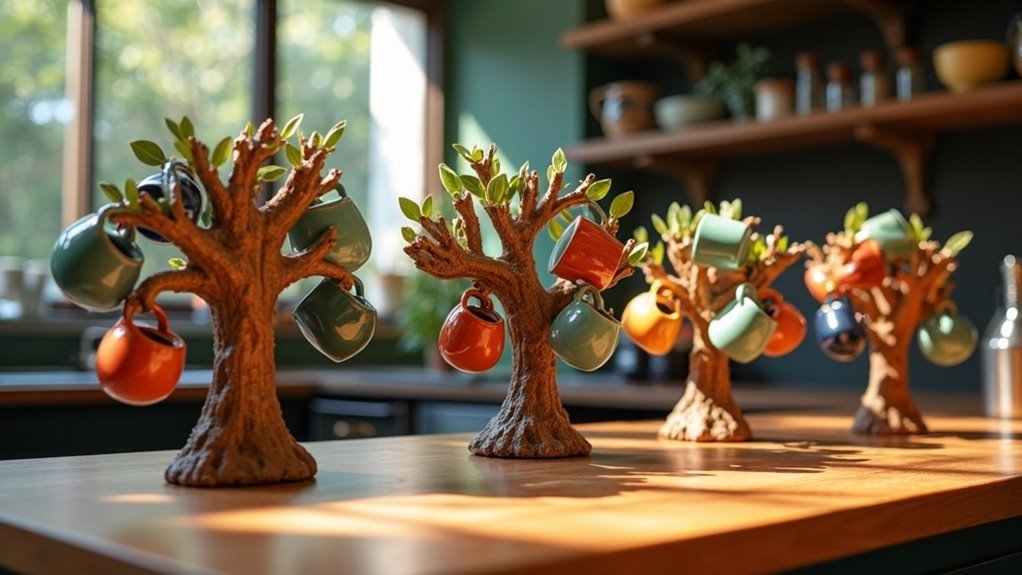K7 coffee varietal, developed in Kenya from the Bourbon-Typica genetic group, is celebrated for its full-bodied taste and mild acidity. Its unique flavor profile features delightful hints of caramel, chocolate, and floral notes, making it a favorite among coffee enthusiasts. Thriving at altitudes of 1200 to 1500 meters, K7 exhibits a medium yield potential and demonstrates resilience against Coffee Berry Disease. By understanding its optimal growth conditions and disease resistance, you can deepen your appreciation for this exceptional varietal and its cultivation.
Key Takeaways
- The K7 coffee varietal, developed in Kenya in 1936 from the Bourbon-Typica genetic group, focuses on individual farmer selection.
- It boasts a full-bodied flavor profile characterized by mild acidity, with delightful notes of caramel, chocolate, and floral undertones.
- Thriving at altitudes between 1200 and 1500 meters, K7 produces cherries within two years, offering a quick return on investment for farmers.
- While K7 is resilient against Coffee Berry Disease, it has low resistance to coffee leaf rust and is susceptible to nematodes.
- Its appealing flavor and adaptability contribute to K7’s popularity among coffee enthusiasts and its value in modern breeding programs in Kenya and Tanzania.
Overview of K7 Coffee Varietal
K7 coffee varietal, developed in Kenya in 1936, represents a notable milestone in coffee breeding achieved through meticulous selection from French Mission coffee over five generations.
This varietal is characterized by its tall stature, light bronze leaf tips, and large beans, which contribute to a medium yield potential. A significant advantage of K7 is its tolerance to Coffee Berry Disease (CBD), making it an attractive option for growers.
However, it does exhibit low resistance to coffee leaf rust and nematodes, which requires careful management practices.
K7 thrives at altitudes between 1200 and 1500 meters and starts producing cherries after two years, showcasing its value in contemporary breeding programs across Kenya and Tanzania.
Genetic Background and Lineage
Originating from the Bourbon-Typica genetic group, the K7 coffee varietal showcases a rich lineage that traces back to the French Mission coffee. Developed by R.H. Walker in Kenya during 1936, K7 coffee emerged through meticulous individual farmer selection over five generations.
This selection process emphasized its bourbon-like genetic background, distinguishing K7 within the broader Bourbon-Typica group. Notably, K7 exhibits a unique growth habit, characterized by spreading young laterals and drooping older primaries.
Its medium to narrow leaves, featuring light bronze young shoot-tips, add to its distinctive appearance, reflecting the careful selection that shaped its genetic background and lineage.
This remarkable varietal not only highlights the complexity of coffee genetics but also contributes to the diverse flavors and qualities sought by coffee enthusiasts.
Key Characteristics and Flavor Profile
K7 coffee showcases a distinctive flavor profile, marked by a full-bodied taste and mild acidity, making it appealing to a diverse array of coffee lovers.
This variety thrives best at lower altitudes between 1200-1500 meters, which enhances its high yield potential.
Although K7 demonstrates some resistance to Coffee Leaf Rust and Coffee Berry Disease, its overall susceptibility necessitates attentive management to preserve its quality.
Unique Flavor Notes
While delving into the K7 coffee varietal, you’ll uncover a flavor profile that enchants with its harmonious blend of sweetness and intricacy. This full-bodied coffee boasts mild acidity, making it suitable for a wide range of taste preferences. With promising yield potential, farmers can anticipate cherries in just two years. Below is a summary of its distinctive flavor notes:
| Flavor Note | Description | Characteristics |
|---|---|---|
| Sweetness | Hints of caramel and fruit | Well-balanced with acidity |
| Complexity | Nuances of chocolate and spice | Engaging and layered |
| Body | Full and rich | Smooth mouthfeel |
| Aroma | Floral undertones | Inviting and fresh |
| Resilience | Tolerance to Coffee Berry Disease | Low resistance to coffee leaf rust |
Growth Conditions
Understanding the growth conditions of the K7 coffee varietal is essential for optimizing its flavor profile and yield potential. Thriving at altitudes between 1200 and 1500 meters above sea level, K7 offers a quick return on investment, producing cherries within two years.
This varietal’s medium yield potential and large bean size enhance its overall quality. The resulting flavor profile features a full-bodied taste with mild acidity, appealing to diverse coffee drinkers.
Although K7 shows some tolerance to coffee leaf rust, it remains vulnerable, emphasizing the importance of managing cultivation conditions to maximize both quality and yield.
Disease Resistance
Although farmers appreciate the K7 coffee varietal for its high yield potential, its disease resistance presents a mixed picture. It shows strong tolerance to Coffee Berry Disease (CBD), which is beneficial for yield, but struggles against coffee leaf rust and nematodes, complicating its cultivation.
| Disease | Resistance Level | Impact on Cultivation |
|---|---|---|
| Coffee Berry Disease | High | Beneficial for yield |
| Coffee Leaf Rust | Low | Significant risk |
| Nematodes | Susceptible | Additional challenges |
Balancing these factors is essential for effective management and optimal production of K7 coffee.
Agronomic Information and Growing Conditions
When growing K7 coffee, you’ll notice its tall growth habit and large bean size, which contribute to its medium yield potential.
This varietal thrives at altitudes between 1200-1500 meters and requires a planting density of 1000-2000 plants per hectare.
Understanding these growth characteristics is essential for optimizing your cultivation practices and maximizing the quality of your coffee harvest.
Growth Characteristics
K7 coffee exhibits distinct growth characteristics that are essential for successful cultivation. This tall stature Arabica variety thrives at altitude conditions between 1200-1500 meters above sea level and requires a planting density of 1000-2000 plants per hectare, utilizing single-stem pruning techniques. Although K7 begins yielding cherries after approximately two years, it demonstrates a medium yield potential. Notably, it shows tolerance to Coffee Berry Disease (CBD) but has low resistance to coffee leaf rust and certain nematodes, which are important factors in coffee cultivation.
| Growth Characteristic | Detail | Importance |
|---|---|---|
| Planting Density | 1000-2000 plants/hectare | Ideal growth |
| Altitude Conditions | 1200-1500 meters | Quality enhancement |
| Yield Potential | Medium yield | Economic viability |
| Resistance to Coffee Berry Disease | Tolerant | Disease management |
| Resistance to Coffee Leaf Rust | Low resistance | Risk management |
Yield Potential
When evaluating the yield potential of the K7 coffee varietal, it’s important to acknowledge its medium yield capacity, which starts producing cherries approximately two years after cultivation.
K7 flourishes at lower altitudes ranging from 1200 to 1500 meters, showcasing its adaptability to these conditions.
With a recommended planting density of 1000 to 2000 plants per hectare, utilizing single-stem pruning techniques, K7 demonstrates a favorable cherry to green bean conversion rate.
However, it’s crucial to be aware that K7 is vulnerable to coffee leaf rust and nematodes, which can adversely affect both productivity and quality, particularly at higher altitudes.
Disease Resistance and Tolerance
Understanding the disease resistance and tolerance of the K7 coffee varietal is essential for growers aiming to optimize their harvests.
K7 exhibits strong tolerance to Coffee Berry Disease, making it resilient against this significant threat to coffee cultivation. However, it shows low resistance to coffee leaf rust and is susceptible to nematodes like Meloidogyne spp. and Pratylenchus spp.
K7 demonstrates notable tolerance to Coffee Berry Disease while remaining vulnerable to coffee leaf rust and certain nematodes.
Evaluations across 23 sites in 15 countries highlight varying local performance, particularly concerning different rust races.
K7’s lineage from French Mission coffee enhances its durability and adaptability, making it a crucial component in modern breeding programs in Kenya and Tanzania for combating coffee diseases and ensuring healthier crops for coffee production.
Yield Potential and Quality
The yield potential and quality of the K7 coffee varietal are remarkable attributes that make it an attractive option for growers in suitable regions.
With a medium yield potential, K7 produces cherries within two years, thriving at altitudes between 1200-1500 m.a.s.l. Its high cherry to green bean outturn guarantees efficient processing, contributing to the production of quality coffee beans.
K7’s full-bodied flavor and mild acidity enhance its market appeal, making it a favorite among coffee enthusiasts.
Additionally, its resilience against certain races of coffee leaf rust and coffee berry disease bolsters its viability, while the large bean size indicates robust growth in favorable conditions, ensuring a consistent supply of high-quality coffee.
Historical Development of K7
Selected in 1936 from French Mission coffee at Legetet Estate in Kenya, K7 represents the culmination of five generations of careful breeding by farmer R.H. Walker. This coffee varietal, belonging to the Bourbon-Typica genetic group, features a unique spreading habit on young laterals and drooping older primaries, making it distinct in the coffee world.
Released in the same year, K7 coffee has become instrumental in modern breeding programs across Kenya and Tanzania, contributing to the rich diversity of coffee cultivation. While it boasts a medium yield potential and thrives at high altitudes, its susceptibility to coffee leaf rust remains a significant concern for coffee farmers.
Evaluated globally, the local performance of K7 coffee varies based on environmental rust races, highlighting the importance of regional adaptability in coffee cultivation.
Comparison With Other Kenyan Coffee Varieties
K7 coffee stands out among Kenyan coffee varieties due to its unique characteristics and adaptability. Originating from the Bourbon variety, K7 offers medium yield potential suitable for lower altitudes, contrasting with SL28 and SL34, which excel at higher elevations and are celebrated for their exceptional cup quality.
K7’s resilience against coffee leaf rust and Coffee Berry Disease enhances its appeal, especially in challenging growing conditions. Unlike Ruiru 11’s compact stature, K7 boasts a larger growth profile, providing diverse flavor options for coffee enthusiasts.
This combination of adaptability and robust flavor makes K7 a remarkable choice for both producers and consumers in the coffee world.








